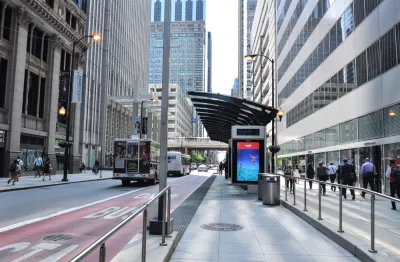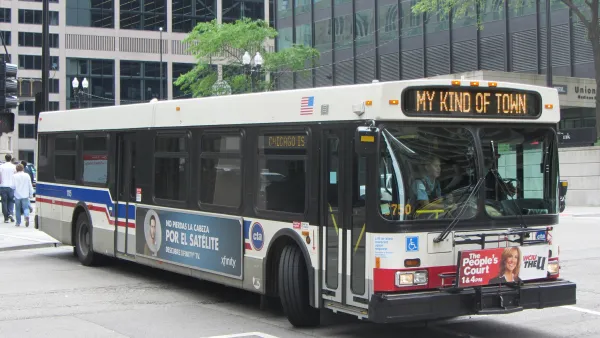In addition to funding the city's roadways and trains, Chicago could use new federal infrastructure dollars to shore up its bus system and invest in bus rapid transit that would improve service for riders.

In an opinion piece in the Chicago Tribune, Amy Rynell, executive director of the Active Transportation Alliance, argues that Chicago's efforts to revitalize its public transit system should focus on buses, particularly bus rapid transit (BRT). As Rynell writes, investing in BRT would bring other positive improvements to the city. "Investments in BRT often come with major upgrades for people walking and biking with wider sidewalks, protected bike lanes and stations that comply with the Americans with Disabilities Act. They spur neighborhood economic development, leading to more affordable housing and small businesses with access to rapid transit."
Rynell calls on city leaders to allocate more resources to bus service, asking "Why aren’t our transportation and transit agencies working together to pursue innovative, equity-focused investments in bus service?" Rynell then describes the city's failed Ashland Avenue BRT project, which she suspects is influencing the city's reluctance to invest in more buses. But Rynell argues in favor of reviving that plan, which was stopped due to opposition from local businesses. According to the article, the Ashland Avenue BRT plan was the most cost-effective proposal evaluated by the regional planning agency, and federal dollars could pay for a substantial portion of the cost of new BRT lines. In the meantime, Rynell also recommends upgrading service with dedicated bus lanes on the city's most-used routes.
FULL STORY: Op-ed: Revitalizing Chicago’s bus rapid transit system should start with Ashland Avenue

National Parks Layoffs Will Cause Communities to Lose Billions
Thousands of essential park workers were laid off this week, just before the busy spring break season.

Retro-silient?: America’s First “Eco-burb,” The Woodlands Turns 50
A master-planned community north of Houston offers lessons on green infrastructure and resilient design, but falls short of its founder’s lofty affordability and walkability goals.

Delivering for America Plan Will Downgrade Mail Service in at Least 49.5 Percent of Zip Codes
Republican and Democrat lawmakers criticize the plan for its disproportionate negative impact on rural communities.

Test News Post 1
This is a summary

Test News Headline 46
Test for the image on the front page.

Balancing Bombs and Butterflies: How the National Guard Protects a Rare Species
The National Guard at Fort Indiantown Gap uses GIS technology and land management strategies to balance military training with conservation efforts, ensuring the survival of the rare eastern regal fritillary butterfly.
Urban Design for Planners 1: Software Tools
This six-course series explores essential urban design concepts using open source software and equips planners with the tools they need to participate fully in the urban design process.
Planning for Universal Design
Learn the tools for implementing Universal Design in planning regulations.
EMC Planning Group, Inc.
Planetizen
Planetizen
Mpact (formerly Rail~Volution)
Great Falls Development Authority, Inc.
HUDs Office of Policy Development and Research
NYU Wagner Graduate School of Public Service



























